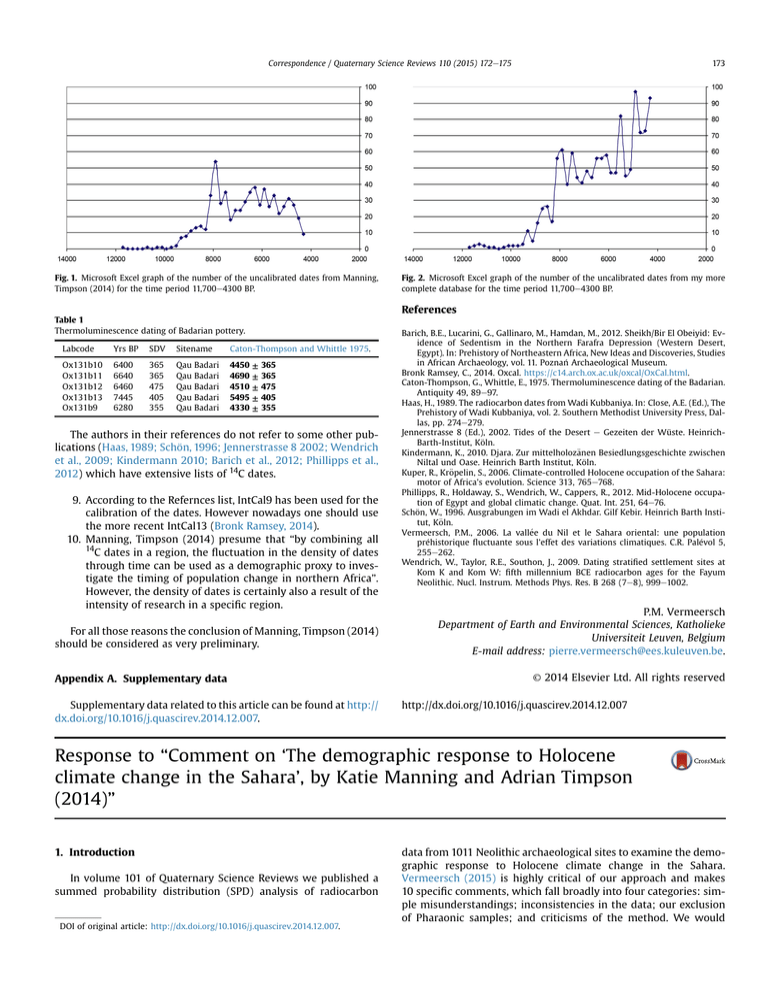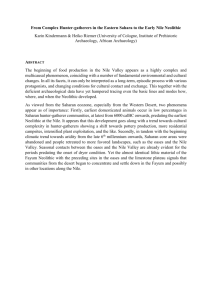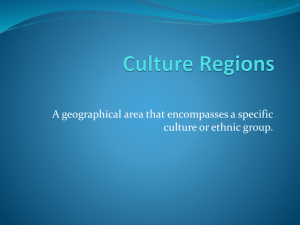
Correspondence / Quaternary Science Reviews 110 (2015) 172e175
Fig. 1. Microsoft Excel graph of the number of the uncalibrated dates from Manning,
Timpson (2014) for the time period 11,700e4300 BP.
173
Fig. 2. Microsoft Excel graph of the number of the uncalibrated dates from my more
complete database for the time period 11,700e4300 BP.
References
Table 1
Thermoluminescence dating of Badarian pottery.
Labcode
Yrs BP
SDV
Sitename
Caton-Thompson and Whittle 1975.
Ox131b10
Ox131b11
Ox131b12
Ox131b13
Ox131b9
6400
6640
6460
7445
6280
365
365
475
405
355
Qau
Qau
Qau
Qau
Qau
4450
4690
4510
5495
4330
Badari
Badari
Badari
Badari
Badari
±
±
±
±
±
365
365
475
405
355
The authors in their references do not refer to some other pub€ n, 1996; Jennerstrasse 8 2002; Wendrich
lications (Haas, 1989; Scho
et al., 2009; Kindermann 2010; Barich et al., 2012; Phillipps et al.,
2012) which have extensive lists of 14C dates.
9. According to the Refernces list, IntCal9 has been used for the
calibration of the dates. However nowadays one should use
the more recent IntCal13 (Bronk Ramsey, 2014).
10. Manning, Timpson (2014) presume that “by combining all
14
C dates in a region, the fluctuation in the density of dates
through time can be used as a demographic proxy to investigate the timing of population change in northern Africa”.
However, the density of dates is certainly also a result of the
intensity of research in a specific region.
For all those reasons the conclusion of Manning, Timpson (2014)
should be considered as very preliminary.
Appendix A. Supplementary data
Supplementary data related to this article can be found at http://
dx.doi.org/10.1016/j.quascirev.2014.12.007.
Barich, B.E., Lucarini, G., Gallinaro, M., Hamdan, M., 2012. Sheikh/Bir El Obeiyid: Evidence of Sedentism in the Northern Farafra Depression (Western Desert,
Egypt). In: Prehistory of Northeastern Africa, New Ideas and Discoveries, Studies
Archaeological Museum.
in African Archaeology, vol. 11. Poznan
Bronk Ramsey, C., 2014. Oxcal. https://c14.arch.ox.ac.uk/oxcal/OxCal.html.
Caton-Thompson, G., Whittle, E., 1975. Thermoluminescence dating of the Badarian.
Antiquity 49, 89e97.
Haas, H., 1989. The radiocarbon dates from Wadi Kubbaniya. In: Close, A.E. (Ed.), The
Prehistory of Wadi Kubbaniya, vol. 2. Southern Methodist University Press, Dallas, pp. 274e279.
Jennerstrasse 8 (Ed.), 2002. Tides of the Desert e Gezeiten der Wüste. Heinrich€ ln.
Barth-Institut, Ko
€nen Besiedlungsgeschichte zwischen
Kindermann, K., 2010. Djara. Zur mittelholoza
€ ln.
Niltal und Oase. Heinrich Barth Institut, Ko
€ pelin, S., 2006. Climate-controlled Holocene occupation of the Sahara:
Kuper, R., Kro
motor of Africa's evolution. Science 313, 765e768.
Phillipps, R., Holdaway, S., Wendrich, W., Cappers, R., 2012. Mid-Holocene occupation of Egypt and global climatic change. Quat. Int. 251, 64e76.
€n, W., 1996. Ausgrabungen im Wadi el Akhdar. Gilf Kebir. Heinrich Barth InstiScho
€ln.
tut, Ko
e du Nil et le Sahara oriental: une population
Vermeersch, P.M., 2006. La valle
historique fluctuante sous l’effet des variations climatiques. C.R. Pale
vol 5,
pre
255e262.
Wendrich, W., Taylor, R.E., Southon, J., 2009. Dating stratified settlement sites at
Kom K and Kom W: fifth millennium BCE radiocarbon ages for the Fayum
Neolithic. Nucl. Instrum. Methods Phys. Res. B 268 (7e8), 999e1002.
P.M. Vermeersch
Department of Earth and Environmental Sciences, Katholieke
Universiteit Leuven, Belgium
E-mail address: pierre.vermeersch@ees.kuleuven.be.
© 2014 Elsevier Ltd. All rights reserved
http://dx.doi.org/10.1016/j.quascirev.2014.12.007
Response to “Comment on ‘The demographic response to Holocene
climate change in the Sahara’, by Katie Manning and Adrian Timpson
(2014)”
1. Introduction
In volume 101 of Quaternary Science Reviews we published a
summed probability distribution (SPD) analysis of radiocarbon
DOI of original article: http://dx.doi.org/10.1016/j.quascirev.2014.12.007.
data from 1011 Neolithic archaeological sites to examine the demographic response to Holocene climate change in the Sahara.
Vermeersch (2015) is highly critical of our approach and makes
10 specific comments, which fall broadly into four categories: simple misunderstandings; inconsistencies in the data; our exclusion
of Pharaonic samples; and criticisms of the method. We would
174
Correspondence / Quaternary Science Reviews 110 (2015) 172e175
like to thank Vermeersch for his comments and we appreciate the
opportunity to provide clarity on these issues and respond in detail
to all points below, with respect to these categories.
1.1. Simple misunderstandings (comments 1 and 6)
A couple of Vermeesch's comments raise questions that we feel
were fully answered in the publication. We regret if our language
caused any ambiguity, and hope to resolve these here.
Comment 1 questions the difference between Figure 3, which
uses 3086 samples, compared to Appendix A, which has 3287 samples. Different scales of analysis, represented in the different figures,
used different subsets of the data. Figure 2 illustrates the full SPD for
the entire radiocarbon data set, inclusive of all 3287 samples, whilst
Figure 3 illustrates the four sub-regional SPDs. Two hundred and one
samples are from sites that were not included in the sub-regional analyses since they were not assigned to one of the four polygons (grey
dots shown and explained in Figure 1). For example, the grey dots in
West Africa, which are located predominantly to the south of the
river Niger, display important social and economic differences to
sites in both the Western littoral and Central Saharan polygons e.g.
arable farming, technological specialisation and Sahelian pottery
motifs (Manning, 2008). It was therefore considered preferable to
exclude them from either polygon.
Comment 6 includes a statement that we have not specified the
time period of interest. We describe in Appendix A that the data ‘ …
covers a calendar date range of 14,000e2000 yrs BP’. This is the same
time range shown on the time-axis in Figures 2, 3 and 4.
1.2. Inconsistencies with the data (comments 2, 3 and 4)
Efforts to clean large datasets (in this case thousands of radiocarbon dates) will never entirely eradicate errors, both human,
and those inherited from other sources. The task therefore is always
to minimise errors to acceptable levels. Even if we accept all Vermeersch's examples (n ¼ 22) this represents only 0.67% of the dataset, a rate so low that it can be considered a commendation of our
data hygiene. An error rate this low will have a negligible affect on
the analysis, and is dwarfed by the uncertainty associated with
archaeological (or any empirical) sampling. Furthermore we do
not agree with all his examples. Comment 2 notes the inclusion
of 11 dates with an unknown lab code. These data were deliberately
included in the analysis, having been obtained from a published
source. The lack of a lab code is an obvious limitation of their provenance, which therefore increases the uncertainty associated with
them, at worst adding noise to the signal. Their inclusion therefore
promotes a more conservative approach.
Comment 3 and 4 criticise the inclusion of five Thermoluminescence (TL) samples, and six duplicate samples. Vermeersch is
indeed correct that both TL samples and duplicates should not
have been included. Nevertheless the detrimental effects of this
are to some extent mitigated by our methods, in two different
ways. Firstly the TL samples have extremely large standard deviations, so their probability distributions are low and diffuse across
a wide period. As with comment 2 this has a conservative effect
of adding some noise to the signal. Secondly, the binning algorithm
(further explained in Timpson et al. 2014) somewhat mitigates
duplicate samples, since they will by definition be assigned to the
same bin, after which their combined probability distribution is
normalised.
1.3. Exclusion of Pharaonic samples (comments 6,7 and 8)
This appears to be Vermeersch's primary criticism, regarding the
inclusion of radiocarbon dates in the eastern Sahara polygon, and
the specific culture history of that region. The key objective of our
publication was to explore spatio-temporal fluctuations in
“Neolithic” populations, and not the adaptive strategies of statelevel societies. This is an important distinction, since the former
are characterised by a less intensive economic and political system
and one that is essentially restricted by an environment's carrying
capacity as a consequence of relatively low technological investment. In contrast, one of the key characteristics of state-level societies is their adoption of what Stuart and Gauthier (1981) termed
“Power strategies” i.e. intensive resource exploitation including
arable farming, complex technology, extensive trade, social stratification and extended political and economic alliances. These sociopolitical developments remove much of the environmental risk
faced by Neolithic populations, and hence provoke a very different
set of questions relating to resilience and climatic change (Weiss
and Bradley, 2001; Turchin, 2003). We are explicit about this in
the publication, stating that our data comes from 1011 “Neolithic
sites” and specifically for the eastern Saharan polygon, that “This
(abrupt population collapse) may be partly explained by the emergence of Pharaonic civilization along the Nile River leading to a spatial
bias in our results as only Neolithic dates are included in this analysis”.
Comment 6 notes a lack of predynastic and Pharaonic samples
post c. 4000 BP. Vermeersch is correct that more Pharaonic dates
are available in the Nile Valley. Similarly there are many more dates
available from sites associated with the Garamantian civilization,
the Kingdom of Kush and other state level societies, which flourished in northern Africa during the late Holocene, and within our
time range of 14,000e2000 yrs BP. However, as we have explained,
the objective of this paper was to explore the population history of
“Neolithic” populations, and not the adaptive strategies of statelevel societies. Comments 7 and 8 again lament the exclusion of
Pharaonic samples, which are present in Vermeersch's own Egyptian dataset, and many of which are published in Kuper and
€pelin (2006). The additional Pharaonic samples are irrelevant
Kro
for the objectives of our analysis, as they would conflate the available Neolithic data with samples derived from Pharaonic contexts,
and tell us little about the response of Neolithic populations to the
€pelin (2006) is
AHP. Similarly the data provided in Kuper and Kro
included in our database, but we have simply removed the Pharaonic samples. Whilst many of the dates from the additional suggested references were included, it is possible that some were
unintentionally missed in our data collection. The size of our dataset is simply the consequence of practical limits in our research
budget. To what extent any empirical sample is fairly representative
of the true population is a fundamental problem to be explored
through appropriate statistics and inference. Hence, the MCSPD
method presented in this paper, specifically tests the degree to
which a population curve deviates from what would be expected
if the distribution was merely a result of random sampling. In this
sense, Vermeersch's description of our data set as “… very incomplete …” and his rhetoric “ How can the database [ … ] be trusted
as being representative for the region?” are unhelpful, since by definition all samples are incomplete approximations of the true
population.
1.4. Criticisms of the method (comments 5, 9 and 10)
In comment 5, Vermeersch suggests the Nile valley should have
been excluded from the analysis, and asserts “… the Nile valley population was not subjected to the same environmental conditions as the
Saharan population”, and the “River Nile cannot be considered as a
Saharan river”. Clearly this is a simple matter of scale. No two points
are ever subjected to exactly the same environmental conditions,
although we can expect closer points to have more similar conditions. As our analysis was at the sub-continental scale, we defined
Correspondence / Quaternary Science Reviews 110 (2015) 172e175
our region of interest, and the River Nile finds itself flowing through
it. Ultimately our results suggest that at this scale, both the eastern
Saharan populations (inclusive of the Nile Valley), the Central Sahara
and the Atlas/Hoggar were subjected to similar climatic drivers. The
inclusion of the Nile Valley data is also well justified on archaeological grounds. There are clear affinities in the material culture and
economic practices of the earliest Holocene populations both in
this region and subsequent settlements to the west, providing
some evidence for the Nile Valley being the source of Neolithic
expansion into the Sahara (Sutton 1974; Gabriel, 1978; Haaland,
1992). To exclude these samples would essentially remove a key
component of Saharan population history, giving the false impression that Neolithic populations did not inhabit the Nile Valley.
Furthermore, Vermeersch plays fast and loose with the problem
of variation in environmental conditions, by implying that the rest
of the Sahara was ecologically homogeneous. This was clearly not
the case, and there has been extensive research documenting the
ecological and palaeohydrological variation of the Saharan Hololy et al., 2014), as
cene (Drake et al., 2011; Francus et al., 2013; He
well as the adaptive strategies adopted by local populations in
response to that variation (Cancellieri and di Lernia, 2013).
At the root of this lies a common issue-the incorrect view that
research at different scales are in some way incongruent. Our publication is not a local scale study of regionally specific demographic
histories, as Vermeersch appears to have interpreted it. Instead we
have provided a broad-scale view of demographic changes at the
sub-continental level. By assessing the similarity in regional population fluctuations across the entire width of Africa we were able
to show strong support for a climatic cause, without needing to
rely on palaeoclimate proxies, and the inherent difficulties they
bring at this scale of analysis.
Comment 9 correctly notes that a more recent calibration curve
has now been published, and it is of course always better to use the
most up-to-date data for any analysis. Nevertheless, subsequent reanalysis using the 2013 intcal. curve, has made no difference to the inferences and conclusions and has a negligible effect on the SPD plots.
Comment 10 raises the point that the shape of the SPD will be
influenced by differences in research intensity in different areas.
This is certainly true, not just for this analysis but for any archaeological analysis, since we are always limited to data from where
someone decided to excavate. This is one of several biases initially
discussed by Rick (1987) when he first proposed constructing
summed date distributions, and has since been dealt with in detail
by many authors including Timpson et al. 2014. Generally, we are
limited in the inferences that can be drawn from regions where
there are simply no data. However, a key aspect of the method
used in this analysis is to account for ‘ascertainment’ bias in regions
where were do have data i.e. to mitigate the effect of single sites
with disproportionate numbers of radiocarbon dates. This is
achieved using a systematic binning process, which ensures that
dates are only assigned to a new bin if there is at least a 200-year
gap since the previous date. This addresses the excavator’s ‘ascertainment’ or ‘wealth’ bias, and ensures that each site-phase is
equally weighted when generating the SPD. Whilst the issue of
sampling bias certainly adds some complexity therefore, it falls
far short of undermining the utility of the methods used.
2. Conclusions
To conclude, a few of Vermeersch's comments are readily
answered in the text itself, nevertheless we hope our reply offers
some additional transparency, particularly in regards to the objectives of our analysis. Other comments are correct in revealing an
extremely low-level error rate in the data, and we are most grateful
for being given the opportunity to amend these. However, it appears
175
that Vermeersch fully grasped neither the objectives of the paper,
nor the methods we have used. The use of radiocarbon dates both
as a valid population proxy and a potential palaeoclimate proxy,
rely on utilising an appropriate scale of observation in both time
and space. This research examined the broad-scale fluctuations in
Neolithic Saharan populations in relation to changes in climate associated with the onset and termination of the AHP. To achieve this we
have deliberately disregarded much of the specific culture histories
of each region, as well as the evident variation in Saharan paleoecology. Whilst this was necessary to reveal the broad-scale fluctuations in Neolithic population levels, it is not our intention to negate
specific regional culture histories. On the contrary, a key objective of
this research was to establish a background trend in the demographic response to Holocene climate change in the Sahara in order
to provide a framework for more localised studies of demographic
change and related ecosystem dynamics.
References
Cancellieri, E., di Lernia, S., 2013. Re-entering the central Sahara at the onset of the Holocene: a territorial approach to Early Acacus hunter-gatherers (SW Libya). Quat.
Int. http://dx.doi.org/10.1016/j.quaint.2013.08.030 (available online 12.09.13.).
Drake, N.A., Blench, R.M., Armitage, S.J., Bristow, C.S., White, K.H., 2011. Ancient watercourses and biogeography of the Sahara explain the peopling of the desert.
PNAS 108, 458e462. http://dx.doi.org/10.1073/pnas.1012231108.
Francus, P., von Suchodoletz, H., Dietze, M., Donner, R.V., Bouchard, F., Roy, A.-J.,
€pelin, S., 2013. Varved sediments of Lake Yoa
Fagot, M., Verschuren, D., Kro
(Ounianga Kebir, Chad) reveal progressive drying of the Sahara during the
last 6100 years. Sedimentology 60, 911e934. http://dx.doi.org/10.1111/j.13653091.2012.01370.x.
Gabriel, B., 1978. Gabrong-achttausendjahrige keramik im Tibesti-Gebirge. In:
Kuper, R. (Ed.), Sahara: 10000 jahren zwischen Weide und Wusten. Museen
der Stadt, Cologne, pp. 189e196.
Haaland, R., 1992. Fish, pots and grain in Early and Mid-Holocene adaptions in the
Central Sudan. Afr. Arch. Rev. 10, 43e64.
ly, C., Le
zine, A.-M., APD contributors, 2014. Holocene changes in African vegetaHe
tion: tradeoff between climate and water availability. Clim. Past 10, 681e686.
€ pelin, S., 2006. Climate-controlled Holocene occupation of the Sahara:
Kuper, R., Kro
motor of Africa's evolution. Science 313, 803e807.
Manning, K., 2008. Mobility, Climate Change and Cultural development. A Revised
View from the Lower Tilemsi Valley, Northeastern Mali (unpublished Phd
thesis). University of Oxford.
Rick, J.W., 1987. Dates as data: an examination of the Peruvian Preceramic radiocarbon record. Am. Antiq. 52, 55e73.
Stuart, D.E., Gauthier, R.P., 1981. Prehistoric New Mexico. Background for Survey.
University of New Mexico Press, Albuquerque.
Sutton, J.E.G., 1974. The African aqualithic. Antiquity 51, 25e34.
Timpson, A., Colledge, S., Crema, E., Edinborough, K., Kerig, T., Manning, K.,
Thomas, M.G., Shennan, S., 2014. Reconstructing regional population fluctuations in the European Neolithic using radiocarbon dates: a new case-study using an improved method. J. Arch. Sci. 52, 549e557.
Turchin, P., 2003. Historical Dynamics: Why States Rise and Fall. Princeton University Press, Princeton.
Vermeersch, P.M., 2015. Comment on “The demographic response to Holocene
climate change in the Sahara”, by Katie Manning and Adrian Timpson (2014).
Quat. Sci. Rev. 110, 172e175.
Weiss, H., Bradley, R.S., 2001. What drives societal collapse? Science 291, 609e610.
Katie Manning*
Institute of Archaeology, University College London, 31-34 Gordon
Square, London, WC1H 0PY, UK
Adrian Timpson
Research Department of Genetics, Evolution and Environment,
University College London, Darwin Building, Gower Street, London,
WC1E 6BT, UK
*
Corresponding author.
E-mail address: k.manning@ucl.ac.uk (K. Manning).
© 2014 Elsevier Ltd. All rights reserved
http://dx.doi.org/10.1016/j.quascirev.2014.12.008








